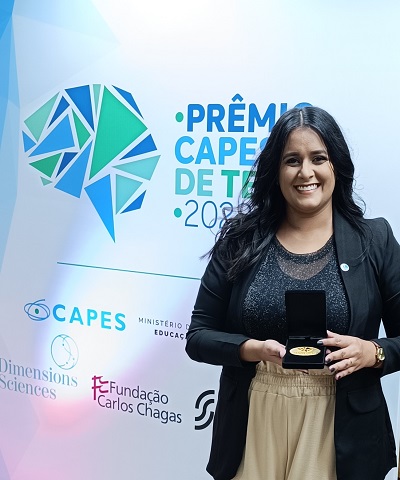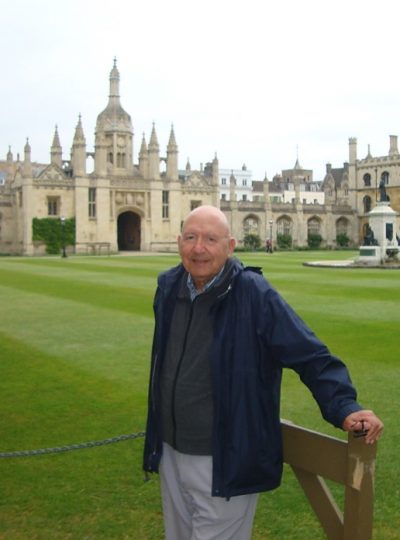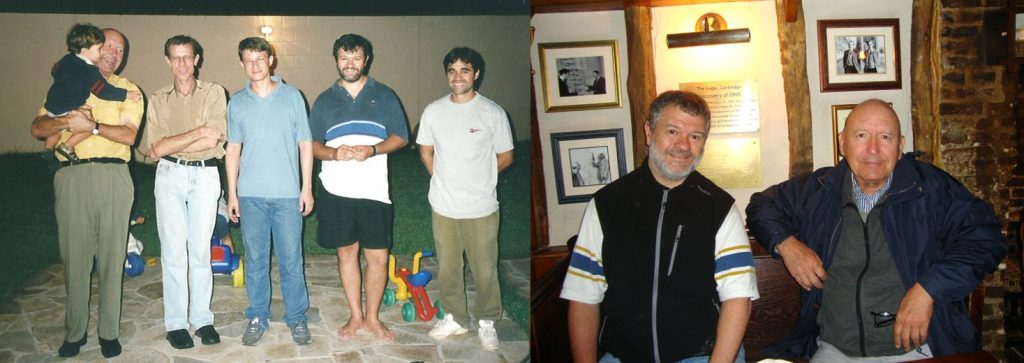 “Science is alive, dynamic, exciting and enriching, and being part of its advancement is a great privilege”, says Ana Elisa Ferreira de Oliveira, winner of the 2023 Capes Prize for Doctoral Dissertation in the area of Materials.
“Science is alive, dynamic, exciting and enriching, and being part of its advancement is a great privilege”, says Ana Elisa Ferreira de Oliveira, winner of the 2023 Capes Prize for Doctoral Dissertation in the area of Materials.
The award distinguished the 49 best doctoral dissertations, one per area of knowledge, defended in Brazilian postgraduate programs in 2022. In addition, 98 honorable mentions were awarded. More than 1,400 works applied for this edition of the Capes Award, whose ceremony was held in Brasília on December 14th.
In her research work, Ana Elisa developed two electrochemical sensors, one made of graphite and the other made of carbon nanotubes, capable of detecting in real time a breast cancer biomarker (the CA 15-3 protein) in biological samples (blood serum and saliva). This protein appears at higher than normal levels in most women with breast cancer after the initial phase of the disease – which is why it can be used to monitor these patients’ response to treatments, as well as to screen for metastasis and detect recurrence of cancer.
The sensors developed in Ana Elisa’s doctorate were produced on paper substrate on which electrodes were printed using conductive inks using simple methods, such as screen printing and handwriting. To detect the CA 15-3 biomarker, the sensors were modified with antibodies to this protein.
The research was carried out under the guidance of Professor Arnaldo César Pereira within the Postgraduate Program in Physics and Chemistry of Materials at the Federal University São João del-Rei (FQMat – UFSJ), in the state of Minas Gerais. However, the work is the result of ten years of scientific training in the area of sensors, from undergraduate research to PhD, always at UFSJ and with the same supervisor.
In this interview for the B-MRS Newsletter, this young scientist, born in Barbacena (interior of Minas Gerais), talks about the sensors and the difficulties and joys of the path she took to complete the best Brazilian Materials dissertation defended in 2022.
B-MRS Newsletter: Tell us a little about your scientific background.
Ana Elisa Ferreira de Oliveira: My academic career began when I entered the Federal University of São João del-Rei (UFSJ) in 2011. I did two “scientific initiations” (undergraduate research) guided by Prof. Dr. Arnaldo, both in the sensor development area. That was the introduction to my career as a researcher. From there, I understood the importance of scientific research and was sure of my desire to continue my studies in postgraduate studies. In 2015, I completed my master’s degree in the Physics and Chemistry of Materials Program at UFSJ, and started my PhD in 2017, in the same program.
When I was writing my doctoral project, I really wanted something in the health area, so I chose the development of sensors to determine biomarkers. But I had to decide what the sensor would determine, which disease. Today breast cancer is the most common type of tumor in women in most parts of the world. Women over 50 are most affected by this type of cancer. Statistically, about one in eight women is diagnosed with breast cancer in her lifetime. Therefore, I decided that in my doctorate I would focus on the application of sensors to determine breast cancer biomarkers.
During my years of research, I published 19 papers in different journals. Between graduation, master’s and doctorate, it was ten years at UFSJ. A decade of lots of study, learning, challenges and personal evolution. I am eternally grateful for the role my university played in my professional journey.
B-MRS Newsletter: What were the biggest challenges you faced in carrying out the award-winning thesis?
Ana Elisa Ferreira de Oliveira: The path during my doctorate was not easy. But, definitely, the main difficulty was the surprise of a global pandemic that at that time had taken the lives of millions around the world. Adapting to a new reality and having the laboratory interrupted for months was challenging. When I finally returned, making up for lost time was extremely tiring. I spent morning, afternoon and night in the laboratory, and often left without results. This was very stressful. However, with a lot of effort and dedication I managed to meet this challenge. And receiving this award just confirms that it was worth it!
The award was a big surprise. I am feeling extremely honored to have my doctoral work recognized by receiving such an important award. It’s an indescribable feeling. I celebrate this victory with everyone who, indirectly or directly, helped me make my dream come true.
B-MRS Newsletter: What are the advantages of the sensors developed in relation to other disease detection techniques?
Ana Elisa Ferreira de Oliveira: Electrochemical sensors have some advantages over conventional techniques: high selectivity and sensitivity, low production cost of the devices, they do not require much maintenance for their use and conservation, the analysis can be done in real time and specialized technicians may not be necessary.
In addition to having a quick response and often without the need for pre-treatment, printed electrodes can be manufactured on a large scale, allowing low-cost production. They are disposable, eliminating the need for cleaning. Consequently, printed sensors are known as low-cost, miniaturized, disposable, and high-sensitivity devices. Printed electrodes can replace the conventional three-electrode system (working, reference, and counter) using conductive inks and a substrate.
B-MRS Newsletter: You assembled the sensor prototypes. What steps would be necessary for these devices to be used outside the laboratory?
Ana Elisa Ferreira de Oliveira: The results of the work suggest the possibility of using printed electrochemical sensors as an alternative for determining CA 15-3 in biological samples. However, there are many more studies that can and should be carried out on these proposed sensors in order for them to become commercial.
They can be further optimized by trying to increase sensitivity and lower the limit of detection and quantification. Another possibility is the modification of printed sensors to determine other biomarkers, not only for cancer, but for other diseases such as cardiovascular diseases.
Electrochemical sensors can also be designed for point-of-care (POC) analysis due to their fast analytical response, possibility of miniaturization and simple operation. POC testing is usually performed in close proximity to the patient, allowing for instant availability of results to make immediate, informed decisions about patient care.
Therefore, some experimental optimizations could be performed on the proposed sensors to reduce analysis time and allow the use of portable potentiostats. Printed electrochemical sensors have great potential in health monitoring and, fortunately, many works are being generated in the literature involving different materials for these purposes. The results of this dissertation corroborate this idea and present a possibility of developing sensitive devices for CA 15-3.
B-MRS Newsletter: Leave a message for our readers who are doing their undergraduate, master’s or doctoral research.
Ana Elisa Ferreira de Oliveira: There is a sentence attributed to Marie Curie that says “Throughout my life, new discoveries about nature have made me happy like a child”. That’s how I felt throughout my academic career. And that’s how I still feel when reading a good article, when developing a project or when I read about new research. Science is alive, dynamic, exciting and enriching. Being part of the advancement of science, even if only in a very small way, is a great privilege.
B-MRS Newsletter: If you would like to make any other comments, feel free.
Ana Elisa Ferreira de Oliveira: I would like to give special thanks to some people who were by my side during this journey. To my parents, sister and nephews for their constant support and encouragement. To my husband Lucas for being by my side at all times. To Mayra, my faithful laboratory companion, for her help and partnership. To Prof. Dr. Lucas Franco Ferreira for the partnership and collaboration. To my colleagues in the research group (Polymer and Electroanalytical Research Group – GPPE), I would like to thank you for your support, collaboration, companionship, pleasant conversations and moments of joy. And in particular, I would like to thank my advisor Prof. Dr. Arnaldo César Pereira for the opportunity granted. He welcomed me as a student nine years ago, and since then we have gone through undergraduate research, master’s degree and now the dreamed doctorate. Thank you for your guidance, conversations and partnership, for trusting in my work and for your constant encouragement. It is difficult to describe in words your importance in my professional journey.



